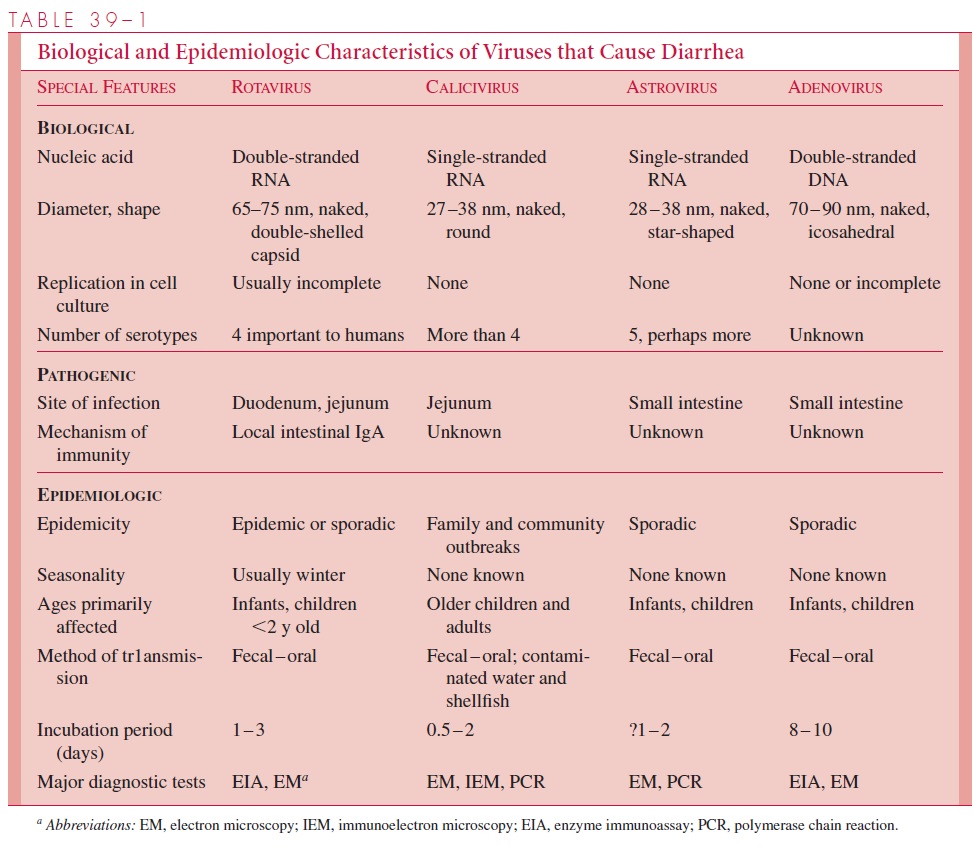Chapter: Medical Microbiology: An Introduction to Infectious Diseases: Viruses of Diarrhea
Viruses of Diarrhea: General Features
Viruses of Diarrhea
Acute diarrheal disease is an illness, usually of rapid evolution (within several hours),that lasts less than 3 weeks. In addition to the bacterial and protozoal agents responsible for approximately 20 to 25% of these cases, viruses are a significant cause of the balance. Rotaviruses, caliciviruses, astroviruses, and some adenoviruses are considered here. Un-fortunately, investigations have been hampered because most of these viruses cannot be readily cultivated in the laboratory.
GENERAL FEATURES
Until the 1970s, proof of viral causation of acute diarrhea was usually based on exclu-sion of known bacterial or protozoan pathogens and supported by feeding cell-free fil-trates of diarrheal stools to volunteers in an attempt to reproduce the disease. As might be expected, the results of such experiments were variable, and the methods were im-practical for routine laboratory diagnosis. One aspect of such infections that proved of great help was the frequent association with abundant excretion of virus particles dur-ing the acute phase of illness. Virion numbers in excess of 108 per gram of diarrheal stool are relatively common, allowing ready visualization with an electron microscope. Direct electron microscopy and immunoelectron microscopy have been frequently used to detect and identify the presumed causative viruses; the latter method can also be used to detect humoral antibody responses to infection. More recently, polymerase chain reactions (PCR) and enzyme immunoassays (EIA) have been increasingly used for diagnosis.
Detection of a specific virus in the stools of symptomatic patients is not sufficient to establish the role of the virus in causing disease. Other criteria to be fulfilled include the following: (1) establish that the virus is detected in ill patients significantly more fre-quently than in asymptomatic, appropriately matched controls and that virus shedding temporally correlates with symptoms; (2) demonstrate significant humoral or secretory antibody responses, or both, in patients shedding the virus; (3) reproduce the disease by experimental inoculation of nonimmune human or animal hosts (usually the most diffi-cult criterion to fulfill); (4) exclude other known causes of diarrhea, such as bacteria, bacterial toxins, and protozoa. Using these criteria, four groups of viruses have been clearly established as important causes of gastrointestinal disease: rotaviruses, cali-civiruses, astroviruses, and some adenovirus serotypes (“enteric” adenoviruses). Other viruses have also been implicated, but all of the preceding criteria have not been fulfilled; therefore, they are currently regarded as “candidate” causes of gastrointestinal disease.
The currently established viruses are listed in Table 39–1 and all have several fea-tures in common, including a tendency toward brief incubation periods; fecal–oral spread by direct or indirect routes; and production of vomiting, which generally pre- cedes or accompanies the diarrhea. The last feature has influenced physicians to usethe term acute viral gastroenteritis to describe the syndrome associated with these agents.

Related Topics